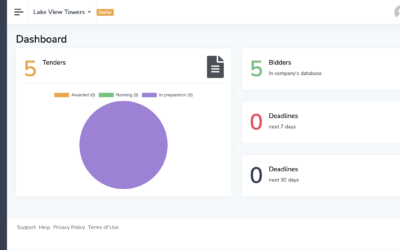Tender management software is a powerful tool for helping your constitution business win more bids, make more money, and stay ahead of the competition.
The software is designed to make the entire process faster and easier so you can beat your competition. Remember: many people will choose the first bid they receive, even if it’s not the best option.
In this short blog, we’ll look at the function of the best tendering software. A good all-in-one tendering software streamlines your processes, helps you avoid mistakes and omissions, and can provide an ROI that is fantastic.
Let’s take a look at tender management software and how it can help a construction business.
What is tendering software?
The Swiss Army knife of construction bidding is tender management software. Consider it as a digital command center that facilitates the management of your tendering procedures from beginning to conclusion. The goal is to improve the system’s overall efficiency, accuracy, and transparency—not merely automate the repetitive tasks.
How can we run a tender process?
Historically, managing a tender process required a lot of paperwork and human labor. After floating the tender, you would wait for bids, manually review each, work out the terms, and then award the contract. These days, all these stages are streamlined by construction tendering software. From the comfort of your office, or even better, from your smartphone while on the road, you may float a tender, sort through proposals, and even conduct your initial round of talks.
What are tender methods?
There are several ways to go about tendering: open, selected, competitive, and negotiated. The ‘best’ approach will depend on the particulars of your project, as each has advantages and disadvantages. You may quickly switch between several tendering techniques with construction tendering software, based on which one best fits your project. It gives you the freedom to alter the tendering procedure to suit your needs.
What are the risks of tendering?
There are risks associated with tendering. There is always a chance that you may overestimate your talents or underestimate expenses. If you win the tender but are unable to deliver on your promises, these errors might lose you a contract or, worse, result in losses. An all-in-one tendering software program can help in this situation. These solutions assist in reducing the risks by offering capabilities like real-time monitoring and historical data analysis. You’ll be equipped with all the knowledge required to make wise choices.
What are the 4 stages of the bidding process?
While from the outside the bidding process appears to be one smooth motion, it can be neatly broken into 4 stages.
For those of us who have tendered bids for a long time, we might have forgotten these, but remembering them and using them will make your construction tendering software more powerful and it will aid in each of the steps more effectively.
Essentially, there are four stages:
1. Prequalification: In this stage, you are evaluating possible bidders, often on the basis of their experience and qualifications.
2. Invitation to Tender: After you’ve narrowed down your applicant pool, you distribute your tender materials, which include a description of the project’s requirements.
3. Evaluation of Bids: In this stage, you examine each bid in detail and compare them according to quality, timeliness, and cost.
4. Contract Award: The best qualified bidder receives the contract after careful examination.
You may get help from tender management software at each of these steps, which will ensure that you don’t overlook any important information and streamline the entire process.
All-in-one tendering software: A business necessity
Software for construction tenders is becoming more and more of a “must-have” rather than a “nice-to-have.”
With so many advantages, moving to a cloud-based tendering system is not something you should pass up, regardless of your level of experience as a small contractor or your level of exposure to the market.
Who wouldn’t want to work smarter, not harder?


